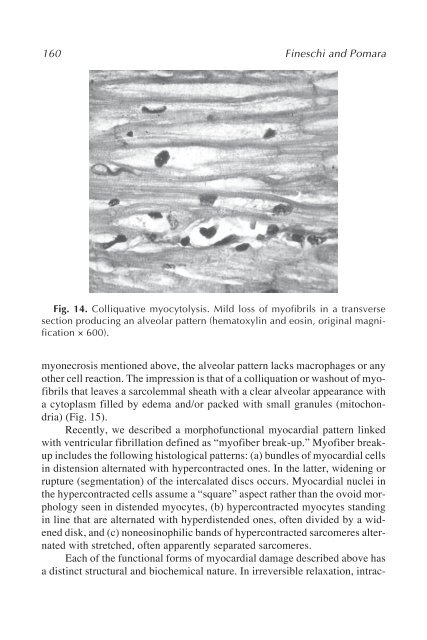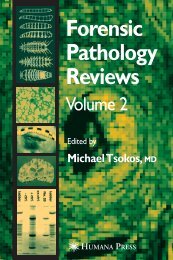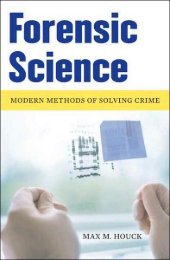- Page 1 and 2:
Forensic Pathology Reviews Volume 1
- Page 3 and 4:
FORENSIC PATHOLOGY REVIEWS Michael
- Page 5 and 6:
© 2004 Humana Press Inc. 999 River
- Page 8 and 9:
Preface The development of speciali
- Page 10 and 11:
Contents Series Introduction.......
- Page 12 and 13:
Contributors MICHAEL BOHNERT, MD
- Page 14 and 15:
Burns 1 Death From Environmental Co
- Page 16 and 17:
Burns 3 1 Morphological Findings in
- Page 18 and 19:
Burns 5 Table 1 Effects of Heat on
- Page 20 and 21:
Burns 7 by dilated skin vessels. Af
- Page 22 and 23:
Burns 9 protrusion of the tongue fr
- Page 24 and 25:
Burns 11 Fig. 3. Heat splits of the
- Page 26 and 27:
Burns 13 Table 2 Classification of
- Page 28 and 29:
Burns 15 3. INTERNAL FINDINGS 3.1.
- Page 30 and 31:
Burns 17 steam was inhaled, the par
- Page 32 and 33:
Burns 19 may have occurred after de
- Page 34 and 35:
Burns 21 Fig. 8. Smoothing of the b
- Page 36 and 37:
Burns 23 19. Maxeiner H (1990) Vita
- Page 38 and 39:
Burns 25 59. Bohnert M, Faller-Marq
- Page 40:
Burns 27 101. Harbitz F (1913) Eige
- Page 43 and 44:
30 Henn and Lignitz
- Page 45 and 46:
32 Henn and Lignitz dependent on th
- Page 47 and 48:
34 Henn and Lignitz Fig. 1. Arched
- Page 49 and 50:
36 Henn and Lignitz Fig. 2. Distrib
- Page 51 and 52:
38 Henn and Lignitz Fig. 3. Lacerat
- Page 53 and 54:
Table 3 Injuries to the Neck in Vic
- Page 55 and 56:
42 Henn and Lignitz Kicking and tra
- Page 57 and 58:
44 Henn and Lignitz Fig. 8. Without
- Page 59 and 60:
46 Henn and Lignitz 3. BIOMECHANICA
- Page 61 and 62:
48 Henn and Lignitz In Greifswald a
- Page 63 and 64:
50 Henn and Lignitz 12. Taere D (19
- Page 65 and 66:
52 Hausmann
- Page 67 and 68:
54 Hausmann Immunohistochemical stu
- Page 69 and 70:
56 Hausmann 5 or 6 months after the
- Page 71 and 72:
58 Hausmann Fig. 1. Inflammatory ce
- Page 73 and 74:
60 Hausmann be observed for MHC I (
- Page 75 and 76:
62 Hausmann (72) found elevated num
- Page 77 and 78:
64 Hausmann Tenascin is an extracel
- Page 79 and 80:
66 Hausmann Table 1 Earliest Appear
- Page 81 and 82:
68 Hausmann Table 2 Earliest and Fr
- Page 83 and 84:
70 Hausmann 17. Oehmichen M, Meißn
- Page 85 and 86:
72 Hausmann 48. Steininger B, van d
- Page 87 and 88:
74 Hausmann 85 Aufderheide E, Eklom
- Page 90 and 91:
CNS Alterations in Drug Abuse 77 Fo
- Page 92 and 93:
CNS Alterations in Drug Abuse 79 4
- Page 94 and 95:
CNS Alterations in Drug Abuse 81 Dr
- Page 96 and 97:
CNS Alterations in Drug Abuse 83 Fi
- Page 98 and 99:
CNS Alterations in Drug Abuse 85 Fi
- Page 100 and 101:
CNS Alterations in Drug Abuse 87 in
- Page 102 and 103:
CNS Alterations in Drug Abuse 89 [5
- Page 104 and 105:
CNS Alterations in Drug Abuse 91 Fi
- Page 106 and 107:
CNS Alterations in Drug Abuse 93 Fi
- Page 108 and 109:
CNS Alterations in Drug Abuse 95 dy
- Page 110 and 111:
CNS Alterations in Drug Abuse 97 (2
- Page 112 and 113:
CNS Alterations in Drug Abuse 99 Fi
- Page 114 and 115:
CNS Alterations in Drug Abuse 101 F
- Page 116 and 117:
CNS Alterations in Drug Abuse 103 a
- Page 118 and 119:
CNS Alterations in Drug Abuse 105 R
- Page 120 and 121:
CNS Alterations in Drug Abuse 107 o
- Page 122 and 123: CNS Alterations in Drug Abuse 109 7
- Page 124 and 125: CNS Alterations in Drug Abuse 111 1
- Page 126 and 127: CNS Alterations in Drug Abuse 113 1
- Page 128 and 129: CNS Alterations in Drug Abuse 115 1
- Page 130 and 131: CNS Alterations in Drug Abuse 117 2
- Page 132 and 133: CNS Alterations in Drug Abuse 119 2
- Page 134 and 135: CNS Alterations in Drug Abuse 121 2
- Page 136 and 137: CNS Alterations in Drug Abuse 123 3
- Page 138 and 139: CNS Alterations in Drug Abuse 125 3
- Page 140 and 141: CNS Alterations in Drug Abuse 127 3
- Page 142 and 143: CNS Alterations in Drug Abuse 129 4
- Page 144 and 145: CNS Alterations in Drug Abuse 131 a
- Page 146 and 147: CNS Alterations in Drug Abuse 133 4
- Page 148 and 149: CNS Alterations in Drug Abuse 135 5
- Page 150 and 151: Sudden Cardiac Death 137 Sudden Dea
- Page 152 and 153: Sudden Cardiac Death 139 5 A Forens
- Page 154 and 155: Sudden Cardiac Death 141 into natur
- Page 156 and 157: Sudden Cardiac Death 143 Davis has
- Page 158 and 159: Sudden Cardiac Death 145 Fig. 1. Co
- Page 160 and 161: Sudden Cardiac Death 147 used for c
- Page 162 and 163: Sudden Cardiac Death 149 Table 2 Sc
- Page 164 and 165: Sudden Cardiac Death 151 Fig. 4. Sc
- Page 166 and 167: Sudden Cardiac Death 153 Fig. 6. Co
- Page 168 and 169: Sudden Cardiac Death 155 Fig. 8. (A
- Page 170 and 171: Sudden Cardiac Death 157 Fig. 10. C
- Page 174 and 175: Sudden Cardiac Death 161 Fig. 15. C
- Page 176 and 177: Sudden Cardiac Death 163 APPENDIX:
- Page 178 and 179: Sudden Cardiac Death 165 LV LVP LV
- Page 180 and 181: Sudden Cardiac Death 167 9. Baroldi
- Page 182 and 183: Neonaticide 169 Child Abuse, Neglec
- Page 184 and 185: Neonaticide 171 6 Medicolegal Probl
- Page 186 and 187: Neonaticide 173 to hide the event f
- Page 188 and 189: Neonaticide 175 Fig. 2. Skeletal re
- Page 190 and 191: Neonaticide 177 Fig. 4. A mother’
- Page 192 and 193: Neonaticide 179 Fig. 6. (A) Umbilic
- Page 194 and 195: Neonaticide 181 Fig. 7. Incised end
- Page 196 and 197: Neonaticide 183 Fig. 8. Aerated lun
- Page 198: Neonaticide 185 9. Saunders E (1989
- Page 201 and 202: 188 Byard and Krous
- Page 203 and 204: 190 Byard and Krous Investigation R
- Page 205 and 206: 192 Byard and Krous In an attempt t
- Page 207 and 208: 194 Byard and Krous (38,39), are gi
- Page 209 and 210: 196 Byard and Krous 7. Adams EJ, Ch
- Page 211 and 212: 198 Byard and Krous infancy. Confid
- Page 213 and 214: 200 Tsokos
- Page 215 and 216: 202 Tsokos dominantly mononuclear i
- Page 217 and 218: 204 Tsokos attachment of mycoplasma
- Page 219 and 220: 206 Tsokos Fig. 2. Bronchiolitis in
- Page 221 and 222: 208 Tsokos Fig. 4. Bronchiolitis ob
- Page 223 and 224:
210 Tsokos The lungs may additional
- Page 225 and 226:
212 Tsokos Fig. 7. Mycoplasma pneum
- Page 227 and 228:
214 Tsokos tract diseases including
- Page 229 and 230:
216 Tsokos 10. Koletsky RJ, Weinste
- Page 231 and 232:
218 Tsokos 48. Mansel JK, Rosenow E
- Page 233 and 234:
220 Sperhake and Tsokos Macroscopic
- Page 235 and 236:
222 Sperhake and Tsokos Fig. 1. Cas
- Page 237 and 238:
224 Sperhake and Tsokos Fig. 4. Cas
- Page 239 and 240:
226 Sperhake and Tsokos Fig. 7. Cas
- Page 241 and 242:
228 Sperhake and Tsokos myocarditis
- Page 243 and 244:
230 Sperhake and Tsokos 10. Lineawe
- Page 246 and 247:
Accidental Autoerotic Death 233 Dea
- Page 248 and 249:
Accidental Autoerotic Death 235 10
- Page 250 and 251:
Accidental Autoerotic Death 237 med
- Page 252 and 253:
Accidental Autoerotic Death 239 Tab
- Page 254 and 255:
Accidental Autoerotic Death 241 rop
- Page 256 and 257:
Accidental Autoerotic Death 243 Fig
- Page 258 and 259:
Accidental Autoerotic Death 245 Fig
- Page 260 and 261:
Accidental Autoerotic Death 247 yok
- Page 262 and 263:
Accidental Autoerotic Death 249 Gow
- Page 264 and 265:
Accidental Autoerotic Death 251 Som
- Page 266 and 267:
Accidental Autoerotic Death 253 Fig
- Page 268 and 269:
Accidental Autoerotic Death 255 Fig
- Page 270 and 271:
7 Attire The victim may be dressed
- Page 272 and 273:
Accidental Autoerotic Death 259 13.
- Page 274 and 275:
Accidental Autoerotic Death 261 55.
- Page 276 and 277:
Lethal Hypothermia 263 11 Lethal Hy
- Page 278 and 279:
Lethal Hypothermia 265 other types
- Page 280 and 281:
Lethal Hypothermia 267 Fig. 2. Hide
- Page 282 and 283:
Lethal Hypothermia 269 Fig. 3. Para
- Page 284 and 285:
Lethal Hypothermia 271 metabolic ra
- Page 286 and 287:
HELLP 273 Maternal Death in Pregnan
- Page 288 and 289:
HELLP 275 12 Pathological Features
- Page 290 and 291:
HELLP 277 In 1982, Weinstein coined
- Page 292 and 293:
HELLP 279 cases of intracerebral he
- Page 294 and 295:
HELLP 281 Fig. 3. Maternal death fr
- Page 296 and 297:
HELLP 283 Fig. 5. Maternal death fr
- Page 298 and 299:
HELLP 285 Table 1 Histomorphologica
- Page 300 and 301:
HELLP 287 4. MEDICOLEGAL ASPECTS Wh
- Page 302 and 303:
HELLP 289 23. Hüskes KP, Baumgartn
- Page 304 and 305:
Resuscitation Injuries 291 Iatrogen
- Page 306 and 307:
Resuscitation Injuries 293 13 Injur
- Page 308 and 309:
Resuscitation Injuries 295 2. POSSI
- Page 310 and 311:
Resuscitation Injuries 297 from 0 t
- Page 312 and 313:
Resuscitation Injuries 299 2.3.2. D
- Page 314 and 315:
Resuscitation Injuries 301 events a
- Page 316:
Resuscitation Injuries 303 34. Mino
- Page 319 and 320:
306 Hunsaker and Hunsaker
- Page 321 and 322:
308 Hunsaker and Hunsaker Many stud
- Page 323 and 324:
310 Hunsaker and Hunsaker Overall,
- Page 325 and 326:
312 Hunsaker and Hunsaker 2.2. Path
- Page 327 and 328:
314 Hunsaker and Hunsaker regulates
- Page 329 and 330:
316 Hunsaker and Hunsaker Significa
- Page 331 and 332:
318 Hunsaker and Hunsaker kinetics
- Page 333 and 334:
320 Hunsaker and Hunsaker tears, sa
- Page 335 and 336:
322 Hunsaker and Hunsaker responds
- Page 337 and 338:
324 Hunsaker and Hunsaker these ant
- Page 339 and 340:
326 Hunsaker and Hunsaker (22,85).
- Page 341 and 342:
328 Hunsaker and Hunsaker same weig
- Page 343 and 344:
330 Hunsaker and Hunsaker Table 3 E
- Page 345 and 346:
332 Hunsaker and Hunsaker If the ch
- Page 347 and 348:
334 Hunsaker and Hunsaker 24. Morse
- Page 349 and 350:
336 Hunsaker and Hunsaker 59. Isbel
- Page 351 and 352:
338 Hunsaker and Hunsaker 97. Basel
- Page 353 and 354:
340 Türk
- Page 355 and 356:
342 Türk Because of the great diff
- Page 357 and 358:
344 Türk surgery (15) or even spec
- Page 359 and 360:
346 Türk Because of the close topo
- Page 361 and 362:
348 Türk hemorrhage. As the lesion
- Page 363 and 364:
350 Türk In hypothermia deaths, ex
- Page 365 and 366:
352 Türk 16. Brown AS, Hancock JE,
- Page 368 and 369:
Index 355 Index A Accidental autoer
- Page 370 and 371:
Index 357 Birth line, 183 Bleeding.
- Page 372 and 373:
Index 359 smoldering, 8 victims, mo
- Page 374 and 375:
Index 361 to head, 35, 36 to inner
- Page 376 and 377:
Index 363 Polymerase chain reaction
- Page 378 and 379:
Index 365 W Washerwoman´s skin, di





